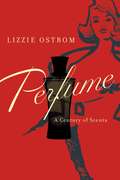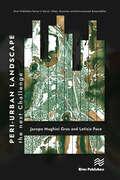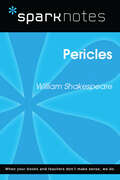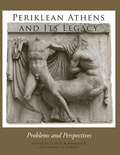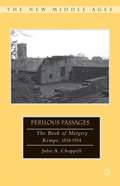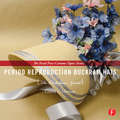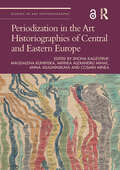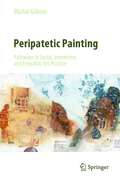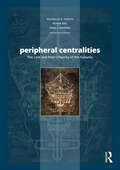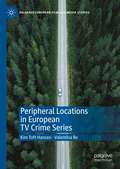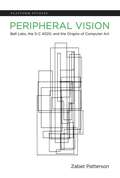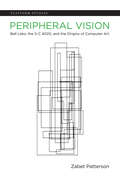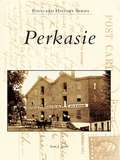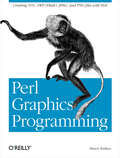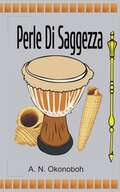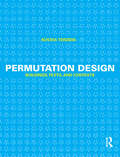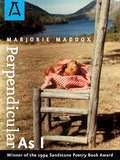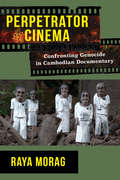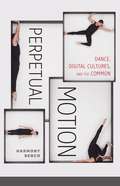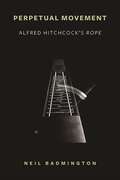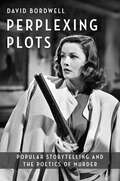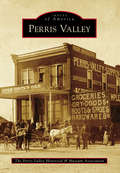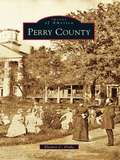- Table View
- List View
Perfume: A Century of Scents
by Lizzie OstromSignature scents and now-lost masterpieces; the visionaries who conceived them; the wild and wonderful campaigns that launched them; the women and men who wore them—every perfume has a tale to tell. Join Lizzie Ostrom on an olfactory adventure as she explores the trends and crazes that have shaped the way we’ve spritzed. One hundred perfumes and scents in all their fragrant glory reveal a fascinating social history of the past century. From the belle epoque through the swinging sixties, to the naughty nineties and beyond, Ostrom brings intelligence and wit to this most ravishing of subjects. There was the patriotic impact of English Lavender during World War I and perfumes that captured the Egyptomania of the 1920's. Estee Lauder created "Youth Dew" and with it, distilled the essence of 1950's suburbia. Patchouli Oil—the "anti-perfume" of the 1960s—was sure to keep money out of the hands of corporations and "the man." And who could forget the fervor created by the grunge androgyny of CK One? Scent is truly the passport to memory, making Perfume both a lush treat and an insightful examination of the twentieth century through the most mysterious of the five sense.
Peri-urban Landscape: The Next Challenge (River Publishers Series in Social, Urban, Economic and Environmental Sustainability)
by Jacopo Mughini Gras Letizia PaceThis book underlines the importance of establishing, in the planning and urban policies oriented towards sustainability, a relationship between the urban expansion – observed in its different forms and dynamics – and the ability of soil and landscape to support agricultural productivity and interface processes. This is the development of a specific investigation theme linked to the problem of soil degradation and peri-urban lands allows a valuable re-interpretation in the field of landscape studies. This book queries the value of the "rural" around a city, in a multidisciplinary perspective encompassing land transformations, good practices, and urban planning trends.Land transformations are at the center of analysis and discussions on the management, planning, and design of the landscape everywhere. This topic is particularly appropriate for European landscapes where land changes are often associated with the degradation of rural and natural areas. This issue represents a crucial point within the framework of the ecological transition towards a truly sustainable society and economy, as established by the European Union.This book is the result of detailed bibliographic research, of in-depth historical research on the most recent challenges and topics of greatest interest in the field of urban studies. Original landscape transformations analyses were performed, introducing also some practical cases, considered relevant contributions in spatial planning.
Pericles (SparkNotes Literature Guide Series)
by SparkNotesPericles (SparkNotes Literature Guide) by William Shakespeare Making the reading experience fun! Created by Harvard students for students everywhere, SparkNotes is a new breed of study guide: smarter, better, faster. Geared to what today's students need to know, SparkNotes provides: *Chapter-by-chapter analysis *Explanations of key themes, motifs, and symbols *A review quiz and essay topicsLively and accessible, these guides are perfect for late-night studying and writing papers
Periklean Athens and Its Legacy: Problems and Perspectives
by Judith M. Barringer Jeffrey M. HurwitThe late fifth century BC was the golden age of ancient Athens. Under the leadership of the renowned soldier-statesman Perikles, Athenians began rebuilding the Akropolis, where they created the still awe-inspiring Parthenon. Athenians also reached a zenith of artistic achievement in sculpture, vase painting, and architecture, which provided continuing inspiration for many succeeding generations. The specially commissioned essays in this volume offer a fresh, innovative panorama of the art, architecture, history, culture, and influence of Periklean Athens. Athenians also reached a zenith of artistic achievement in sculpture, vase painting, and architecture, which provided continuing inspiration for many succeeding generations. The specially commissioned essays in this volume offer a fresh, innovative panorama of the art, architecture, history, culture, and influence of Periklean Athens.
Perilous Passages
by Julie A. ChappellOn December 27, 1934, the American scholar Hope Emily Allen announced in The Times the reappearance of a late medieval manuscript called The Book of Margery Kempe. Perilous Passages: The Book of Margery Kempe, 1534-1934 explores the various paths by which this late medieval manuscript made its way out of a monastery in Yorkshire during Henry VIII's religious reformation to the home of a family of deep English and Catholic roots in the twentieth century. Julie A. Chappell reveals new evidence that implicates the Carthusians as conscious preservers of this manuscript between 1534 and 1537 and significantly furthers our understanding of the ways in which the unique autobiography of Margery Kempe, lay woman turned mystic and visionary, was interpreted. Most importantly, this fascinating study bridges the gaps in our understanding of the transmission of texts from the medieval past to the present.
Period Reproduction Buckram Hats: The Costumer’s Guide (The Focal Press Costume Topics Series)
by Crystal G. HermanWhether you’re in a professional or a community theatre, part of a historical re-enactment, or teaching costume construction, a well-made hat provides a much-needed finishing touch to a costume. Period Reproduction Buckram Hats: The Costumer’s Guidebook is your one-stop resource for learning how to recreate historically accurate buckram hats. Each chapter is devoted to the construction of a particular hat, beginning with a historical image and followed by an list of the exact amount of fabric, tools, and materials needed and the estimated time to complete the construction. Every chapter contains a brief historical background on each hat, a pattern, step-by-step instructions, process photographs, and ideas for altering the pattern to fit your unique production. This book not only provides instruction for the exacting reproduction of historic hats, but it also guides and encourages you to alter patterns and techniques to create your own designs. The final chapters outline general millinery principles that can be applied to almost any hat, allowing you to customize your project.
Periodization in the Art Historiographies of Central and Eastern Europe (Studies in Art Historiography)
by Shona Kallestrup Magdalena Kunińska Mihnea Alexandru Mihail Anna Adashinskaya Cosmin MineaThis volume critically investigates how art historians writing about Central and Eastern Europe in the late nineteenth and early twentieth centuries engaged with periodization. At the heart of much of their writing lay the ideological project of nation-building. Hence discourses around periodization – such as the mythicizing of certain periods, the invention of historical continuity and the assertion of national specificity – contributed strongly to identity construction. Central to the book’s approach is a transnational exploration of how the art histories of the region not only interacted with established Western periodizations but also resonated and ‘entangled’ with each other. In their efforts to develop more sympathetic frameworks that refined, ignored or hybridized Western models, they sought to overcome the centre–periphery paradigm which equated distance from the centre with temporal belatedness and artistic backwardness. The book thus demonstrates that the concept of periodization is far from neutral or strictly descriptive, and that its use in art history needs to be reconsidered. Bringing together a broad range of scholars from different European institutions, the volume offers a unique new perspective on Central and Eastern European art historiography. It will be of interest to scholars working in art history, historiography and European studies.
Peripatetic Painting: Pathways in Social, Immersive, and Empathic Art Practice
by Michal GliksonThis book documents the practice-led research of painting as a peripatetic art practice through travel and transient life in Australia, India, and Pakistan. Crossing disciplines of Art, Applied Anthropology, and Cultural Geography, painting is explored as a way of negotiating the uncertainties inherent in cross-cultural journeys, and the possibility of connecting with others in their lifeworlds. The ways of navigating and of making that support creativity in the field are identified, as are the multifarious conditions of the field in view of how these shaped painting, and ultimately, the consciousness of the artist through possibilities for empathy, advocacy, and activism. The book includes many images that illustrate the form which painting took in the field and the techniques employed to create these. Interactive links in the eBook edition enable the reader to view documentary films about subjects with whom the artist worked, and that illustrate the field and conditions of making. Throughout the book the reader may also engage with virtual tours of the Australindopak Archive as the art work generated by this research.
Peripheral Centralities: The Lost and Past Urbanity of the Suburbs (Planning, History and Environment Series)
by Paul J. Maginn Roger Keil Nicholas A. PhelpsThe term ‘peripheral centralities’ may seem something of an oxymoron and yet the spatial peripheries of cities have often been more central to urban development processes than is appreciated. To better understand the nature of peripheral centrality, Peripheral Centralities: The Lost and Past Urbanity of the Suburbs brings together a wide variety of examples of lost and forgotten peripheral centralities of different sizes, purpose, geographical location, and political complexion, dating from the first decades of the twentieth century to the present day. Following the introduction, two chapters provide broad overviews of peripheral centralities in international and national systems of centralities. The next four chapters look at plans from settings as different as Dublin and Shanghai that, for one reason or another, failed to materialize. The following eight chapters each describes cases where projects have been realized, ranging from peripheral townships in England to a Chinese steel city. To conclude the book, the editors highlight the themes revealed in the foregoing chapters and consider the part an appreciation of peripheral centralities might play in the development of urban theory from the outside in.
Peripheral Locations in European TV Crime Series (Palgrave European Film and Media Studies)
by Kim Toft Hansen Valentina ReThis book is a comprehensive study of peripheral locations in contemporary European TV crime series. Ambitiously, it covers the complete geography of Europe, and offers a nuanced image of a changing, dynamic, and unfinished continent. The chapters include analyses of the practical, creative approach to producing crime series in European peripheries and rural areas, evaluating a continent marked by an internal crisis between urban and rural Europe. The study includes readings of crime series such as Shetland, Bitter Daisies, Trom, Pagan Peak, and The Border, but presents such representative cases within broader tendencies on the European TV market, including challenges from streaming services, the influence of Nordic Noir, and changes within the cognitive geography of Europe. The authors position peripheral European crime series in a complex relationship between universal appeal and local recognisability and offer a comprehensive theoretical approach to the aesthetics of peripherality. Grounded in desktop production studies, the book presents an original scholarly approach to analysing European crime series from a continental point of view. Despite local differences, the spatio-generic orientations scrutinized in the book – Nordic Noir, Mediterranean Noir, Country Noir, Eastern Noir, and Brit Noir – show remarkable aesthetic similarities in series from territories otherwise normally unconnected in television production. Consequently, television crime series reveal a common tongue and voice for dialogue on a continent in a deepening crisis.
Peripheral Vision
by Zabet PattersonIn 1959, the electronics manufacturer Stromberg-Carlson produced the S-C 4020, a device that allowed mainframe computers to present and preserve images. In the mainframe era, the output of text and image was quite literally peripheral; the S-C 4020 -- a strange and elaborate apparatus, with a cathode ray screen, a tape deck, a buffer unit, a film camera, and a photo-paper camera -- produced most of the computer graphics of the late 1950s and early 1960s. At Bell Laboratories in Murray Hill, New Jersey, the S-C 4020 became a crucial part of ongoing encounters among art, science, and technology. In this book, Zabet Patterson examines the extraordinary uses to which the Bell Labs SC-2040 was put between 1961 and 1972, exploring a series of early computer art projects shaped by the special computational affordances of the S-C 4020. The S-C 4020 produced tabular data, graph plotting and design drawings, grid projections, and drawings of axes and vectors; it made previously impossible visualizations possible. Among the works Patterson describes are E. E. Zajac's short film of an orbiting satellite, which drew on the machine's graphic capacities as well as the mainframe's calculations; a groundbreaking exhibit of "computer generated pictures" by Béla Julesz and Michael Noll, two scientists interested in visualization; animations by Kenneth Knowlton and the Bell Labs artist-in-residence Stan VanDerBeek; and Lillian Schwartz's "cybernetic" film Pixillation.Arguing for the centrality of a peripheral, Patterson makes a case for considering computational systems not simply as machines but in their cultural and historical context.
Peripheral Vision: Bell Labs, the S-C 4020, and the Origins of Computer Art (Platform Studies)
by Zabet PattersonHow the S-C 4020—a mainframe peripheral intended to produce scientific visualizations—shaped a series of early computer art projects that emerged from Bell Labs.In 1959, the electronics manufacturer Stromberg-Carlson produced the S-C 4020, a device that allowed mainframe computers to present and preserve images. In the mainframe era, the output of text and image was quite literally peripheral; the S-C 4020—a strange and elaborate apparatus, with a cathode ray screen, a tape deck, a buffer unit, a film camera, and a photo-paper camera—produced most of the computer graphics of the late 1950s and early 1960s. At Bell Laboratories in Murray Hill, New Jersey, the S-C 4020 became a crucial part of ongoing encounters among art, science, and technology. In this book, Zabet Patterson examines the extraordinary uses to which the Bell Labs SC-2040 was put between 1961 and 1972, exploring a series of early computer art projects shaped by the special computational affordances of the S-C 4020. The S-C 4020 produced tabular data, graph plotting and design drawings, grid projections, and drawings of axes and vectors; it made previously impossible visualizations possible. Among the works Patterson describes are E. E. Zajac's short film of an orbiting satellite, which drew on the machine's graphic capacities as well as the mainframe's calculations; a groundbreaking exhibit of “computer generated pictures” by Béla Julesz and Michael Noll, two scientists interested in visualization; animations by Kenneth Knowlton and the Bell Labs artist-in-residence Stan VanDerBeek; and Lillian Schwartz's “cybernetic” film Pixillation.Arguing for the centrality of a peripheral, Patterson makes a case for considering computational systems not simply as machines but in their cultural and historical context.
Perkasie (Postcard History)
by Ivan J. JurinPerkasie, named after William Penn's country manor in Upper Bucks County, was a boomtown that sprang up along the North Pennsylvania Railroad in the late 1870s. From the 1880s to the 1920s, Perkasie grewrapidly, becoming a transportation and cultural center and drawing crowds with commerce, industry, summer retreats, and even an amusement park. Through nearly 200 vintage postcards, Perkasie chronicles the expansion of this once small town as well as its impact on neighboring rural communities such as Rockhill, Bedminster, and Silverdale. The postcards in this book re-create a visual memory of the economic and social changes that worked to shape this dynamic community.
Perl Graphics Programming: Creating SVG, SWF (Flash), JPEG and PNG files with Perl (O'reilly Ser.)
by Shawn WallaceGraphics programmers aren't the only ones who need to be proficient with graphics. Web and applications programmers know that a dull web page can be quickly transformed into one that's interesting and lively with the use of well-planned graphics. And fortunately, you don't need the skills of a fulltime graphics programmer to use graphics effectively. From access counters and log report graphs to scientific plots and on-the-fly animated GIFs, graphics scripting is within the grasp of most web programmers. Using open source software, like Perl, you have the power to dynamically generate graphics based on user input and activity, easily manipulate graphics content, and optimize graphics for compression and quality.Geared toward Perl users and webmasters, Perl Graphics Programming focuses on open-source scripting programs that manipulate graphics files for use on the Web. The book demystifies the manipulation of graphics formats for newcomers to the Web with a practical, resource-like approach. With this book you'll learn to:Generate dynamic web graphics with charts, tables, and buttonsAutomate graphics tasks (thumbnails and borders)Create dynamics web documents (PDF, Postscript)Produce rich Internet experiences with Flash and SVGYou'll begin with a tour of the most common web graphic file formats--PNG, JPEG, GIF, SWF, SVG, Postscript and PDF--then you'll explore the most powerful tools and Perl modules available for manipulating these graphics, such as GD, PerlMagick, and GIMP. Included in this part of the book is a thorough description of the Ming module for creating on-the-fly Flash files. Next, a "cookbook" section includes practical, all purpose recipes: GIF animation, generating images within a dynamic application, communicating between SWF front-end and Perl back-end, XSLT transformations, compression, and much more.Perl programmers naturally turn to Perl to tackle whatever challenge they have at hand, and graphics programming is no exception. Perl Graphics Programming provides all the tools you need to begin programming and designing graphics for the Web immediately. This book will change how you think about generating and manipulating graphics for the Web.
Perle Di Saggezza
by A. N. Okonobohparole di saggezza, detti saggi, vecchi detti, filosofia dei saggi e cultura antica. questo è quello che troverete nel libro. quest'ultimo è diverso dalla solita raccolta di proverbi che si trova nelle opere di saggezza orientali. La gamma antologica qui è ampia, in modo da ospitare detti per donne e uomini, bambini e genitori, salmi nuziali, piante e animali, realtà e astratto, essenziale e banalità e sposa e sposo. L'Africa faraonica culla della civiltà e i continenti intelligenti del mito e della leggenda sono evidenziati con colori culturali. E l'opera scosta la cortina di questi gioielli tradizionali tramandati oralmente, andando così come missionari nella terra delle culture straniere. Come lettore, vedrai meglio nel libro, dipinto in vividi quadri di parole, l'identità africana e l'arte della storia che è spesso presente in abiti, piumini, cuscini, placche, orecchini, braccialetti, collane e regali, insieme a divertenti citazioni e ritmi. I proverbi e gli indovinelli sono una parte importante della vita tradizionale africana. Cercano di far emergere una serie di consigli ponderati, comprensione, verità, morali e avvertimenti sia in modo serio che umoristico. Evocano significati dalle esperienze quotidiane, mostrano l'unità della comunità e si collegano alla spiritualità biblica. La bellezza di questa raccolta è la generosa latitudine verso molti possibili significati, dato che non viene fatto alcun tentativo di suggerirne uno. Se non diversamente indicato, tutti i proverbi qui sono accreditati agli Ishans, una piccola tribù minoritaria di Edo, Nigeria. Tuttavia, la maggior parte sono conosciuti in altre tribù e i loro messaggi sono veri per la gente di tutto il mondo. Questo libro guadagnerà pubblico tra le famiglie e i lettori che cercano di trovare la saggezza delle parole. Scoprite quindi perché" La stanza di un bambino piccolo non è sufficiente per una mascherata per travestirsi". E perché "Un uomo d
Permanent Red: Essays in Seeing
by John BergerWhy should an artist&’s way of looking at the world have any meaning for us? Any artwork reflects the artist&’s intentions, but also its times: therefore all art is politicalIn Permanent Red, John Berger argues that the contemporary artist should strive for a realism that aims for hope, to transform the world. Surveying the work of historical artists as well as that of near contemporaries such as Picasso, Léger and Matisse, he explores the role of the artist, dividing these figures into those that struggle, those that fail, and the true masters. He explains why we should study the work of the past: in order to understand the present and to rethink the future.First published in 1960, Permanent Red established John Berger as a firebrand critic willing to broadcast controversial opinions on some of the most important British artists of the day, including Henry Moore and Barbara Hepworth.
Permutation Design: Buildings, Texts, and Contexts
by Kostas TerzidisIn design, the problems that designers are called upon to solve can be regarded as a problem of permutations. A permutation is an ordered arrangement of elements in a set. In our case, the set is design and the elements are design components, such as lines, shapes, forms, or spaces. Traditionally, such arrangements are done by human designers who base their decision-making process either on intuition or on random sampling until a valid solution is found. However, in both cases the solution found may be an acceptable one but cannot be labeled as "the best possible solution" due to the subjective or arbitrary nature of the selection process. In contrast, by harnessing the potential of computational design, these elements can be arranged in all possible ways and then the best ones are chosen based on specific criteria. By presenting a complete list of permutation-based arrangements the "best solution" will eventually reveal itself by excluding all other possible solutions. This book comprehensively addresses theories, techniques, and examples of permutation design in order to fully demonstrate to the reader the full range of possibilities this method represents. The significance of such an approach to design is enormous, paradigmatic, and far-reaching. It provides an alternative method for design analysis, synthesis, and evaluation that is based on computational force rather than pure human intelligence alone. In contrast to human-based random sampling or intuition, permutation-based design offers the assurance of an optimum design since any possible alternative design can be eliminated. From a practical point of view, this methodology offers a paradigmatic shift away from the current state of design practice where arbitrariness, repetition, and redundancy often exist. From a theoretical viewpoint, this new paradigm will offer alternative insights into the value of human creativity, intuition, and intelligence.
Perpetrating Selves: Doing Violence, Performing Identity
by Clare Bielby Jeffrey Stevenson MurerThis volume explores violent perpetration in diverse forms from an interdisciplinary and transnational perspective. From National Socialist perpetration in the museum, through post-terrorist life writing to embodied performances of perpetration in cosplay, the collection draws upon a series of historical and geographical case studies, seen through the lens of a variety of texts, with a particular focus on the locus of the museum as a technology of sense making. In addition to its authored chapters, the volume includes three contributed interviews which offer a practice-led perspective on the topic. Through its wide-ranging approach to violence, the volume draws attention to the contested and gendered nature of what is constructed as ‘perpetration’. With a focus on perpetrator subjectivity or the ‘perpetrator self’, it proposes that we approach perpetration as a form of ‘doing’; and a ‘doing’ that is bound up with the ‘doing’ of one’s gendered identity more broadly. The work will be of great interest to students and scholars working on violence and perpetration in the fields of History, Literary Studies, Area Studies, Women’s and Gender Studies, Museum Studies, Cultural Studies, International Relations and Political Science.
Perpetrator Cinema: Confronting Genocide in Cambodian Documentary (Nonfictions)
by Raya MoragPerpetrator Cinema explores a new trend in the cinematic depiction of genocide that has emerged in Cambodian documentary in the late twentieth- and early twenty-first centuries. While past films documenting the Holocaust and genocides in Yugoslavia, Rwanda, and elsewhere have focused on collecting and foregrounding the testimony of survivors and victims, the intimate horror of the autogenocide enables post–Khmer Rouge Cambodian documentarians to propose a direct confrontation between the first-generation survivor and the perpetrator of genocide. These films break with Western tradition and disrupt the political view that reconciliation is the only legitimate response to atrocities of the past. Rather, transcending the perpetrator’s typical denial or partial confession, this extraordinary form of “duel” documentary creates confrontational tension and opens up the possibility of a transformation in power relations, allowing viewers to access feelings of moral resentment.Raya Morag examines works by Rithy Panh, Rob Lemkin and Thet Sambath, and Lida Chan and Guillaume Suon, among others, to uncover the ways in which filmmakers endeavor to allow the survivors’ moral status and courage to guide viewers to a new, more complete understanding of the processes of coming to terms with the past. These documentaries show how moral resentment becomes a way to experience, symbolize, judge, and finally incorporate evil into a system of ethics. Morag’s analysis reveals how perpetrator cinema provides new epistemic tools and propels the recent social-cultural-psychological shift from the era of the witness to the era of the perpetrator.
Perpetual Motion: Dance, Digital Cultures, and the Common (Electronic Mediations #59)
by Harmony BenchA new exploration of how digital media assert the relevance of dance in a wired world How has the Internet changed dance? Dance performances can now be seen anywhere, can be looped endlessly at user whim, and can integrate crowds in unprecedented ways. Dance practices are evolving to explore these new possibilities. In Perpetual Motion, Harmony Bench argues that dance is a vital part of civil society and a means for building participation and community. She looks at how, after 9/11, it became a crucial way of recuperating the common character of public spaces. She explores how crowdsourcing dance contributes to the project of performing a common world, as well as the social relationships forged when we look at dance as a gift in the era of globalization. Throughout, she asks how dance brings people together in digital spaces and what dance&’s digital travels might mean for how we experience and express community. From original research on dance today to political economies of digital media to the philosophy of dance, Perpetual Motion provides an ambitious, invigorating look at a commonly shared practice.
Perpetual Movement: Alfred Hitchcock's Rope (SUNY series, Horizons of Cinema)
by Neil BadmingtonThe first book-length study in English of Alfred Hitchcock's Rope (1948), Perpetual Movement offers both a production history that draws extensively upon little-known archival materials, including set drawings and drafts of the screenplay, and a close examination of the film in which Neil Badmington analyzes each of Rope's eleven shots. Writing in an accessible and engaging style, Badmington explores the film's treatment of space, sound, editing, sexuality, source material, design, intertexuality, narrative, and music. He looks at Hitchcock's struggle with censorship while planning, shooting, and distributing the film. Perpetual Movement also addresses Rope's reception and legacy, explaining why the film's unusual qualities provide such lasting appeal for viewers.
Perplexing Plots: Popular Storytelling and the Poetics of Murder (Film and Culture Series)
by David BordwellNarrative innovation is typically seen as the domain of the avant-garde. However, techniques such as nonlinear timelines, multiple points of view, and unreliable narration have long been part of American popular culture. How did forms and styles once regarded as “difficult” become familiar to audiences?In Perplexing Plots, David Bordwell reveals how crime fiction, plays, and films made unconventional narrative mainstream. He shows that since the nineteenth century, detective stories and suspense thrillers have allowed ambitious storytellers to experiment with narrative. Tales of crime and mystery became a training ground where audiences learned to appreciate artifice. These genres demand a sophisticated awareness of storytelling conventions: they play games with narrative form and toy with audience expectations. Bordwell examines how writers and directors have pushed, pulled, and collaborated with their audiences to change popular storytelling. He explores the plot engineering of figures such as Raymond Chandler, Agatha Christie, Dashiell Hammett, Patricia Highsmith, Alfred Hitchcock, Dorothy Sayers, and Quentin Tarantino, and traces how mainstream storytellers and modernist experimenters influenced one another’s work. A sweeping, kaleidoscopic account written in a lively, conversational style, Perplexing Plots offers an ambitious new understanding of how movies, literature, theater, and popular culture have evolved over the past century.
Perris Valley (Images of America)
by Perris Valley Historical & Museum AssociationThe brave pioneers who arrived throughout the late 1800s in covered wagons or on trains to the desolate San Jacinto Plains, as it was called at that time, saw beauty in the picturesque mountain ranges and blue skies and were beholden to their new home in what was to become the Perris Valley. Ready to start their new lives, many came for the health benefits provided by the dry climate. The Perris Valley has come a long way from its rural farming roots. It is now highly diversified and urbanized. Several exciting venues are part of Perris Valley today, including the Orange Empire Railway Museum, which is the largest rail museum in the western United States, and the internationally renowned Skydive Perris.
Perry County
by Eleanor C. DrakePerry County has been a major player in the history of Alabama. Native Americans lived and hunted on its land, and it became a county before Alabama gained statehood. Early citizens chose to name it for Oliver Hazard Perry, a hero of the War of 1812. The people of Perry County have played major roles over the years, which include the following: one married Sam Houston; one served as Alabama's first governor during the Civil War; one designed the Confederate flag and uniform; one married Martin Luther King; one was slain by a state trooper, triggering the Selma-to-Montgomery march; and another was the wife of Andrew Young. Along with its history, Perry County is an educational center and the location of many homes that predate the Civil War. Images of America: Perry County features samples of its rich history in photographs.
